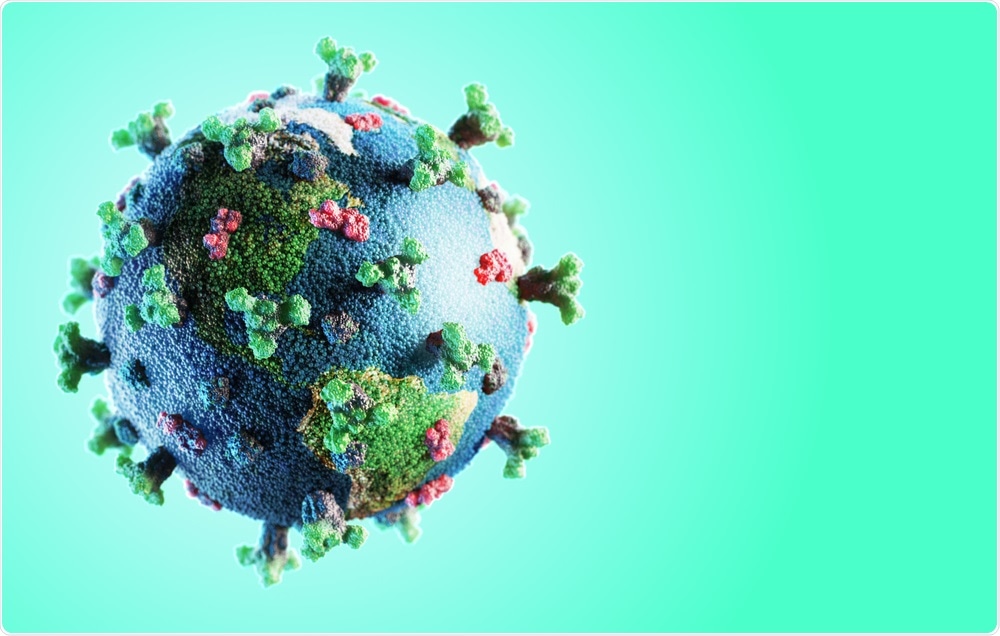
The severe acute respiratory syndrome coronavirus-2 (SARS-CoV-2) antagonizes interferon (IFN)-mediated host defenses for infection establishment. SARS-CoV-2 nucleocapsid proteins further enhance its pathogenicity by suppressing IFN signaling to various degrees, with the open reading frame 6 (ORF6) protein being the strongest IFN antagonist.
Several previous research studies have demonstrated that ORF6 suppresses IFN signaling by localizing to multiple membranous compartments of host cells, including the nuclear pore complex (NPC). To this end, ORG6 directly interacts with nuclear-pore components Nup98-Rae1 through its C-terminal domain to impair docking of karyopherin/importin complex, thereby disrupting nuclear-translocation of activated STAT1/IRF3 transcription factors. However, these studies have not yet explored the direct cause-and-effect relationship between ORF6 localization and IFN antagonism experimentally.

Study: Decoupling SARS-CoV-2 ORF6 localization and interferon antagonism. Image Credit: creativeneko / Shutterstock.com
About the study
In a recent preprint study published on the bioRxiv* server, researchers deployed mutagenesis studies to investigate the relationship between ORF6 localization and IFN antagonism. Herein, they demonstrated that ORF6 uses two structural determinants for interacting with membranous compartments of host cells.
Further, the researchers demonstrate that ORF6 is a peripheral membrane protein, rather than a transmembrane protein as previously speculated. In addition, they demonstrated the potency of mislocalized ORF6 variants to induce cytoplasmic accumulation of importin-α, which inhibits nuclear trafficking.
Study findings
The researchers first identified protein regions of ORF6 that dictated its subcellular distribution. To this end, they generated a panel of ORF6-mCherry truncation mutants co-expressed in HeLa cells with markers for the endoplasmic reticulum (ER) and Golgi apparatus.
The C-terminal region of ORF6 interacts with Nup98-Rae1 NPC and induces the cytoplasmic accumulation of importin-α. It was observed during the analysis that the expression of amino acid residues 1-47 in HeLa cells resulted in localization to several membraneous organelles, which was similar to wild-type localization, while the residues 48-61 showed no discernable localization pattern.
Further analysis of the amino acid segments (1-47) showed that the first half (residues 1-23) partially co-localized with the Golgi marker, while the second half (residues 24-47) resulted in localization to an organelle distinct from the ER. Upon further truncating the 1-23 segment to residues 1-17, the researchers did not see a localization pattern, thus suggesting that segment 18-24 dictates Golgi retention.
To further validate these observations, they examined residues 18-47 and found that these did not mimic wild-type distribution. In lieu, this mutant localized to the ER-adjacent organelle, thereby suggesting that the putative helix contained within the 1-17 fragment also contributes to steady-state localization.
Taken together, these observations validated that ORF6 maintains steady-state localization through at least two distinct determinants. These include the first longer protein determinant, which resides within amino acid residues 1-47 that mediates steady-state membrane associations, and a second region from 18-24 that dictates Golgi retention.
Furthermore, the researchers examined a panel of localization disrupted mutants for their ability to block enhanced green fluorescent protein-karyopherin α-2 (eGFP-KPNA2) trafficking. They stably introduced eGFP-KPNA2 in type II alveolar lung epithelial cell line A549 to test ORF6 activity. Remarkably, all the tested mutants induced cytoplasmic accumulation of eGFP-KPNA2 at efficiencies comparable to the wild-type strain of SARS-CoV-2.
The researchers then treated A549 cells with type I IFN and assessed STAT1 localization in the presence or absence of ORF6 proteins. As expected, all mutants could inhibit the nuclear accumulation of STAT1 at efficiencies comparable to wild-type, thereby suggesting that mutant ORF6 is potent in blocking the nuclear accumulation of activated STAT1. These findings further validated that ORF6 localization was independent of IFN antagonism.
Moreover, researchers established SARS-CoV-2 ORF6 as a peripheral membrane protein. They tested single amino acid substitution mutants that exchanged the wild-type residue with the one having opposing biophysical properties on the respective helical surfaces. The polar and hydrophobic amino acid residues were replaced with tryptophan and glutamate, respectively, and charged residues were exchanged with opposing charges, then assessed for localization.
The substitutions made only to the hydrophobic membrane-interacting surface would have exhibited disrupted localization if ORF6 was a peripheral membrane protein. The results demonstrated that all ORF6 mutants with substitutions on the hydrophobic surface showed mislocalized subcellular distribution patterns, thus indicating that SARS-CoV-2 ORF6 is a peripheral membrane protein that maintains steady-state localization through the 18-24 amino acid residues region and the adjacent hydrophobic surface.
Conclusions
The current study outlines several observations about the SARS-CoV-2 ORF 6, which is a nucleocapsid protein whose primary function is to suppress antiviral innate immune signaling or IFN signaling of the host for establishing SARS-CoV-2 infection. The results revealed that ORF6 actively associates with several membranous compartments through two distinct structural determinants during infection and is most likely a peripheral-membrane protein.
More importantly, the results demonstrated that mislocalized ORF6 variants potently induce cytoplasmic accumulation of importin-α, thus inhibiting nuclear trafficking. Further, the study results showed that ORF6 localization was independent of IFN antagonism, raising the possibility of ORF6 serving additional functions within membrane networks.
*Important notice
bioRxiv publishes preliminary scientific reports that are not peer-reviewed and, therefore, should not be regarded as conclusive, guide clinical practice/health-related behavior, or treated as established information.
- Wong, H. T., Cheung, V., & Salamango, D. J. (2021). Decoupling SARS-CoV-2 ORF6 localization and interferon antagonism. bioRxiv. doi:10.1101/2021.12.06.47141. https://www.biorxiv.org/content/10.1101/2021.12.06.471415v1
Posted in: Molecular & Structural Biology | Medical Science News | Medical Research News | Disease/Infection News
Tags: Amino Acid, Cell, Cell Line, Coronavirus, Coronavirus Disease COVID-19, Fluorescent Protein, Golgi Apparatus, HeLa Cells, Helix, Interferon, Membrane, Organelle, Protein, Research, Respiratory, SARS, SARS-CoV-2, Severe Acute Respiratory, Severe Acute Respiratory Syndrome, Syndrome, Transcription, Transcription Factors, Tryptophan

Written by
Neha Mathur
Neha Mathur has a Master’s degree in Biotechnology and extensive experience in digital marketing. She is passionate about reading and music. When she is not working, Neha likes to cook and travel.
Source: Read Full Article